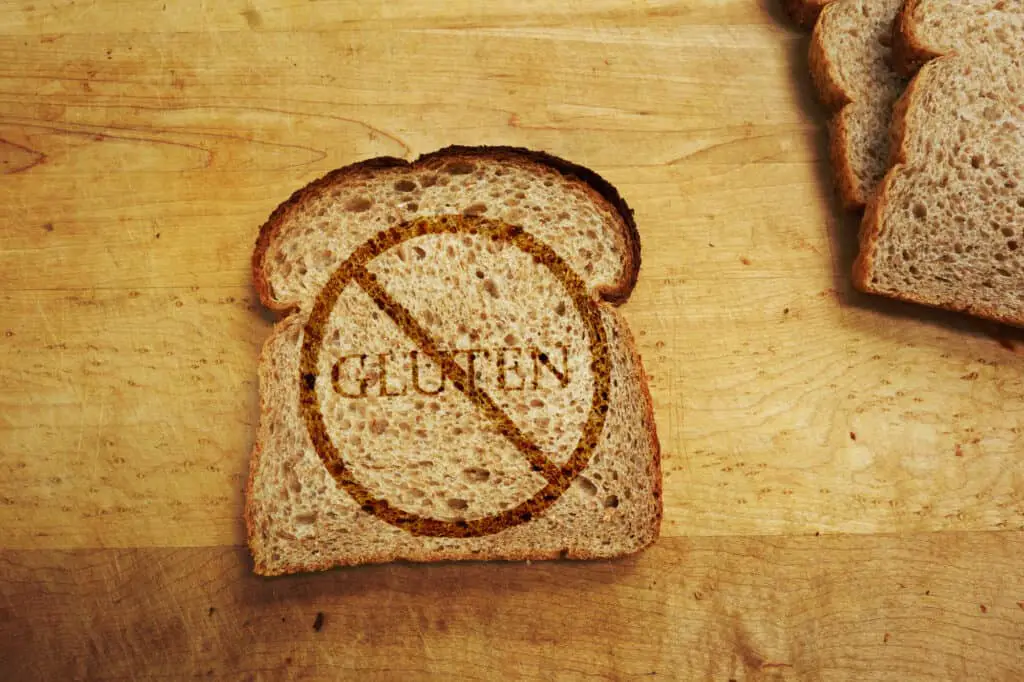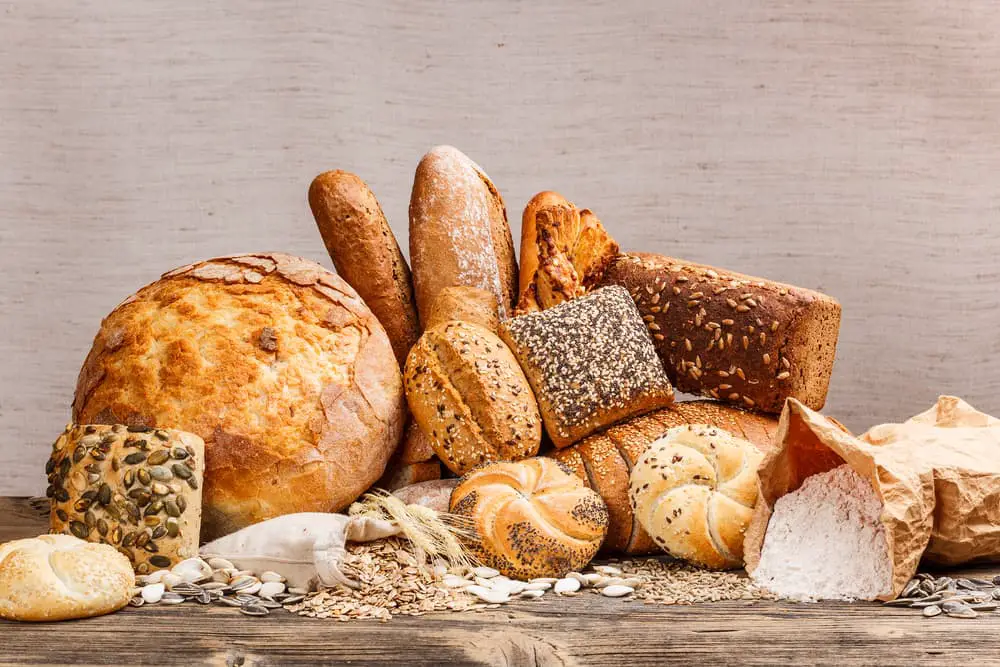Baking is therapeutic, and there is nothing better than the smell of baked goods wafting through your kitchen or house. Bread may very well be the most fundamental staple in many households, so you must do it treat it with respect by using the right ingredients, bread flour being paramount. This piece will discuss bread flour nutrition, including value, and its gluten content. We will also look at how good it is for our bodies, the different bread flour types in the market, and how to store them.
Bread Flour Nutrition, By the Cup
Calories: 495
Carbs: 95.3 g
Protein: 12.91 g
Sugars: 0.4 g
Fats: 2.3 g
Sodium: 2.7 mg
Fiber: 3.3 g
Is Bread Flour Gluten-Free?

Bread flour has among the highest amount of gluten of any flour, ranging from 12 to 14 percent. This type of flour works best in yeast bread. The gluten helps the bread rise and stretch while maintaining its structure.
What is the Gluten Content in Bread Flour?
Gluten content varies with flour and what it is you are baking. For instance, cake flour has the lowest amount of gluten, averaging at 9%, and it’s best for desserts that are low in gluten, such as cakes, muffins, and pastries. On the other hand, bread flour has the highest gluten content ranging between 12 and 14% and is best for baking bread, dinner rolls, bagels, and pretzels.
Is It Healthy?
Bread flour is healthy as it contains folic acid, niacin, and vitamin B-9, essential in your body. Folic acid helps the process and utilization of energy in your body. It is also vital for your mental and emotional well-being.
Pregnant women are advised to take folic acid supplements during their pregnancy. It helps in brain functions and the production of chromosomal building blocks in your body, DNA and RNA.
However, bread flour can be detrimental to your health when misused, mainly when processed excessively with additives. Likewise, consuming too many goods baked with bread flour can also be bad for your health as it can lead to obesity, heart issues, and diabetes. So, exercise moderation when eating baked goods. We know….that is easier said than done.
One tough thing about bread flour nutrition when it comes to weight: Highly processed bread flour doesn’t have fiber, making you feel satiated. Instead, you will feel hungry soon after, leading to weight gain.
Low-Carb Bread Flour

If you are looking for low-carb bread flour, almond flour fits the bill. This flour is made from ground almonds and is extremely low in carbs. Specifically, two tablespoons of almond flour contains a total only three grams of carbs with a net of 1 gram. Some of the low-carb bread flour best sellers include: LifeSource Foods Oat Fiber and Anthony’s Vital Wheat Gluten.
Keto Bread Flour
Keto bread flour is best for people on the keto diet and looking for low-carb bread flour. This type of bread flour does not contain any soft or hard wheat. Keto flour is made of almond, coconut, and pork rind dust. Some of the best keto-friendly flours include Anthony’s Vital Wheat Gluten, Grain4Grain, and Pork Panko.
Are Additives Included?
White bread flour contains additives as it is bleached with chlorine gas, of which there are remnants. However, unbleached bread flour doesn’t have any additives, so it’s more expensive.
Enriched Bread Flour
Enriched bread flour refers to flour whose nutrients are replenished after being stripped off during production. Some of the nutrients that are returned to enrich bread flour include iron and vitamins such as riboflavin, thiamine, folic acid, and niacin. The enrichment process helps the flour create nutritional value.
Some people use enrichment and fortification interchangeably, but they are different terms. Fortification involves adding new nutrients to the flour, standard practice with wheat and maize flour.
When talking about bread flour nutrition, we need to address the elephant in the room: weight gain.
Weight gain is associated with high-carb foods like bread flour, but it can also help you lose weight. If you make a habit of eating whole wheat bread flour moderately, you are bound to lose weight as it has more fiber, vitamins, and minerals, which makes you feel full, preventing you from overeating.
Also, if you want to lose weight, do not restrict yourself from wheat entirely as the next time you get a taste, there are high chances you’ll overdo it, undoing all hard work.
So, eat goods baked with bread flour but do it in moderation, and if possible, avoid white bread flour and use whole wheat bread flour. This is because white bread flour is stripped of all the fiber and vitamins, so it doesn’t make your feel full, prompting you to eat more.
Is It Easy to Digest?
There are two types of bread flour: whole wheat bread flour and white bread flour. Whole wheat bread flour has more nutrients as it retains the bran, germ, and endosperm. This means it has more fiber, which is good for digestion, as it absorbs more water, making it easy to digest and excrete.
White bread flour is not ideal for many people as it is stripped of vitamins, fiber, minerals, and vitamins. Still, for people who have Crohn’s Disease, IBS, and ulcerative colitis, white bread flour is perfect as it has less fiber, making it easier to digest. However, it causes a spike in your blood sugar as it breakdown to produce more glucose. So if you are going to use white bread flour to bake bread, make sure to use organic nut butter to help stabilize your blood sugar levels. As one might expect, bread flour nutrition may vary depending upon your own personal health conditions.
Unbleached Bread Flour

This flour is composed of refined wheat, where only the endosperm is left as the bran and germ are removed during processing. Since there are no preservatives and chemicals, unbleached bread flour ages naturally, giving it longer shelf life. The flour has a denser and tougher texture, which is why it’s used in specific recipes.
Most flours, unbleached and bleached, have some of their nutrients added back, and in this case, vitamin B and iron are replenished but not fiber. Fiber is crucial in our digestive system as it reduces constipation and helps minimize the risks of heart disease and cancer.
High-Protein Bread Flour
Wheat flour has two types of protein: glutenin, responsible for elasticity and chewiness, and gliaden, responsible for the rising. For the protein to be activated, you must add water.
Durum wheat flour is a type of bread flour that comprises the highest protein content of all wheat flour. However, when the protein is activated to produce gluten, it does not give it enough elasticity, so it needs to be used in conjunction with other flours.
Durum wheat contains 27% of wet gluten, 3% more than common wheat. Because of strength and hardness, it is mainly used to make pizza and noodles.
Whole wheat flour is easy to digest as it is rich in antioxidants, fiber, and protein. It is also great for people looking to lose weight, and it does not cause a spike in your blood sugar levels.
How To Store Bread Flour
If you want to use all your bread flour, make sure to store it appropriately; otherwise, it will go bad very quickly. When storing your bread flour, ensure no air remains in the bag and keep the lid tightly sealed.
Flours are absorbers, so make sure to keep them away from things such as onion, soap, and other strong-smelling products. If you want to extend your flour’s shelf life, keep it in the fridge.
Does Bread Flour Go Bad?
Yes. Bread flour goes bad when it exceeds its shelf life or is not stored properly. Bread flour has a shelf life of three to six months. When it is stored in the fridge, however, it can last for about one year. White bread flour can last longer because it has a lower fat content. On the other hand, whole wheat bread flour and other gluten-free flour may spoil sooner.
When flour is exposed to air or moisture, it causes the fats in the flour to oxidize, reducing the flour’s quality. The majority of wheat flours do not have an odor, but when it has gone bad, it will have a rancid smell, and other times it will have a musty or sour odor.
Another sign that your bread flour has gone bad is the presence of beetles, popularly known as weevils. This is usually brought on by not packaging or storing it well. Although they are not harmful to your body, it is important to kill them immediately to prevent discoloration or foul odor. You can do this by refrigerating your bread flour if you choose to try to save the bread flour.
Our take: toss it.
Expired Bread Flour

You can bake with expired bread flour, but the baked goods will taste weird. In rare instances, you might get sick after eating goods baked with expired bread flour, especially when the level of mycotoxin is high. This is a toxic chemical produced by mold. Fortunately, it is pretty easy to tell if your flour has high mycotoxins as it has a strong rancid, musty, or sour smell. So before buying bread flour, check the expiry date; it is usually written best-before (BB) date on the flour packaging.
Summing Up
If you are a fan of bread like us, it is best to understand the different types of bread flour and what benefit or harm it brings to your body. We hope this information helped to inform you!
